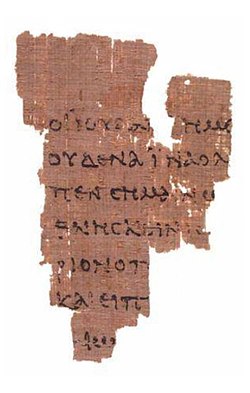The collection
The Rylands Papyri collection held by the John Rylands University Library, is one of the most extensive and wide-ranging papyrus manuscript collections in the United Kingdom. It includes religious, devotional, literary and administrative texts. The collection includes 7 hieroglyphic and 19 hieratic papyri which are funerary documents dating from the 14th century BCE to the 2nd century CE. It also holds 166 demotic papyri, mostly dating from the Ptolemaic period, including the famous Petition of Petiese (pRylands 9) [3] from the reign of Darius I of Persia. [4]
The collection also houses about 500 Coptic papyri, and around 800 Arabic papyri consisting of private letters, together with tradesmen's and household accounts. Among the roughly 2,000 Greek papyri are the famous fragments of the Gospel of John and Deuteronomy, the earliest surviving fragments of the New Testament and the Septuagint (Papyrus 957, the Rylands Papyrus iii.458) [4] [5] respectively; Papyrus 31, a fragment of a papyrus manuscript of the Epistle to the Romans ; and Papyrus 32, a fragment of the Epistle to Titus. Also held in the collection is Papyrus Rylands 463, a copy of the apocryphal Gospel of Mary in Greek, and John Rylands Papyrus 470, a prayer in Koine Greek to the Theotokos, written between 3rd to 9th centuries [6] [7] in brown ink, the earliest known copy of such a prayer. It was acquired by the Library in 1917. [8]
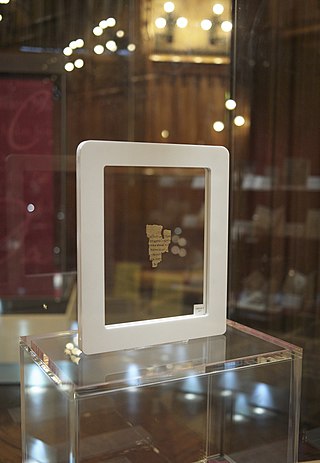
The Rylands Library Papyrus P52, also known as the St John's fragment and with an accession reference of Papyrus Rylands Greek 457, is a fragment from a papyrus codex, measuring only 3.5 by 2.5 inches at its widest, and conserved with the Rylands Papyri at the John Rylands University Library Manchester, UK. The front (recto) contains parts of seven lines from the Gospel of John 18:31–33, in Greek, and the back (verso) contains parts of seven lines from verses 37–38. Since 2007, the papyrus has been on permanent display in the library's Deansgate building.

The Bodmer Papyri are a group of twenty-two papyri discovered in Egypt in 1952. They are named after Martin Bodmer, who purchased them. The papyri contain segments from the Old and New Testaments, early Christian literature, Homer, and Menander. The oldest, P66 dates to c. 200 AD. Most of the papyri are kept at the Bodmer Library, in Cologny, Switzerland outside Geneva.

There have been many Coptic versions of the Bible, including some of the earliest translations into any language. Several different versions were made in the ancient world, with different editions of the Old and New Testament in five of the dialects of Coptic: Bohairic (northern), Fayyumic, Sahidic (southern), Akhmimic and Mesokemic (middle). Biblical books were translated from the Alexandrian Greek version.

Papyrus 2 is an early copy of the New Testament in Greek and Coptic. It is a papyrus fragment of a copy of the Gospel of John dating to the sixth century. It is currently housed at the Egyptian Museum, Florence. There is a portion of Luke 7:22-26.50 in Coptic on the reverse of the fragment.
A biblical manuscript is any handwritten copy of a portion of the text of the Bible. Biblical manuscripts vary in size from tiny scrolls containing individual verses of the Jewish scriptures to huge polyglot codices containing both the Hebrew Bible (Tanakh) and the New Testament, as well as extracanonical works.

The Oxyrhynchus Papyri are a group of manuscripts discovered during the late nineteenth and early twentieth centuries by papyrologists Bernard Pyne Grenfell and Arthur Surridge Hunt at an ancient rubbish dump near Oxyrhynchus in Egypt.
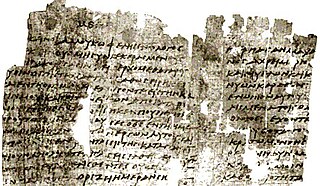
Papyrus 13, designated by siglum 𝔓13 or P13 in the Gregory-Aland numbering, is a fragmentary manuscript of the New Testament in Greek. It was copied on papyrus in the 3rd century at approximately 225-250 CE.

The Chester Beatty Biblical Papyri or simply the Chester Beatty Papyri are a group of early papyrus manuscripts of biblical texts. The manuscripts are in Greek and are of Christian origin. There are eleven manuscripts in the group, seven consisting of portions of Old Testament books, three consisting of portions of the New Testament, and one consisting of portions of the Book of Enoch and an unidentified Christian homily. Most are dated to the 3rd century CE. They are housed in part at the Chester Beatty Library in Dublin, Ireland, and in part at the University of Michigan, among a few other locations.

Papyrus 5, designated by siglum 𝔓5, is an early copy of the New Testament in Greek. It is a papyrus manuscript of the Gospel of John dating palaeographically to the early 3rd century. The papyrus is housed in the British Library. It has survived in a very fragmentary condition.

Papyrus 6, designated by 𝔓6 or by ε 021, is a fragmentary early copy of the New Testament in Greek and Coptic (Akhmimic). It is a papyrus manuscript of the Gospel of John that has been dated paleographically to the 4th century. The manuscript also contains text of the First Epistle of Clement, which is treated as a canonical book of the New Testament by the Coptic Church. The major part of the codex is lost.
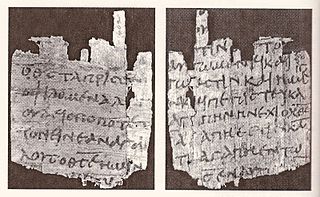
Papyrus 9, signed by 𝔓9, and named Oxyrhynchus papyri 402, is an early copy of the New Testament in Greek. It is a papyrus manuscript of the First Epistle of John, dating paleographically to the early 3rd century.

Papyrus 17, signed by 𝔓17, is an early copy of the New Testament in Greek. It is a papyrus manuscript of the Epistle to the Hebrews, but only contains verses 9:12-19. The manuscript has been paleographically assigned to the 4th century. However, according to Philip Comfort it is from the late 3rd century.

Papyrus 21, designated by siglum 𝔓21, is an early copy of the New Testament in Greek. It is a papyrus manuscript of the Gospel of Matthew, it contains only Matthew 12:24-26.32-33. The manuscript paleographically had been assigned to the early 4th century.
Papyrus 31, designated by 𝔓31, is an early copy of the New Testament in Greek. It is a papyrus manuscript of the Epistle to the Romans, it contains only Romans 12:3-8. The manuscript paleographically has been assigned to the 7th century. The reverse side is blank. It is possible that it was used as a talisman. Hunt suggested it was a lectionary.

Papyrus 32, designated by 𝔓32, is an early copy of the New Testament in Greek. A papyrus manuscript of the Epistle to Titus, it contains only Titus 1:11-15; 2:3-8. On the basis of paleography, the manuscript has been assigned a date around A.D. 200.
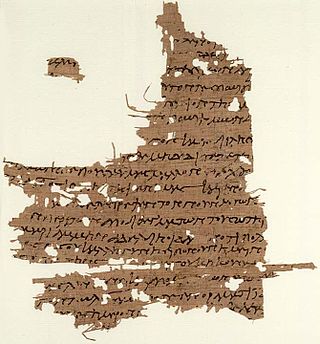
Papyrus Oxyrhynchus L 3525 is a copy of the apocryphal Gospel of Mary in Greek. It is a papyrus manuscript formed in a roll. The manuscript had been assigned palaeographically to the 3rd century. It is one of the three manuscripts and one of the two Greek manuscripts of the Gospel of Mary. It is shorter than Papyrus Rylands 463.
Papyrus Rylands 463 is a copy of the apocryphal Gospel of Mary in Greek. It is a papyrus manuscript in roll form. The manuscript has been assigned palaeographically to the 3rd century. It is one of the three manuscripts and one of the two Greek manuscripts of the Gospel of Mary. It is longer than Papyrus Oxyrhynchus L 3525.

Papyrus Oxyrhynchus 8 is a fragment of Greek hexameter poetry. The dialect is a mixture of Aeolic and Doric. It was discovered by Grenfell and Hunt in 1897 in Oxyrhynchus. The fragment is dated to the first or second century. It is housed in the Houghton Library, Harvard University, with the catalogue number SM2211. The text was published by Grenfell and Hunt in 1898.

Papyrus Oxyrhynchus 655 is a papyrus fragment of the logia of Jesus written in Greek. It is one of the Oxyrhynchus Papyri discovered by Grenfell and Hunt between 1897 and 1904 in the Egyptian town of Oxyrhynchus. The fragment is dated to the early 3rd century. It is one of only three Greek manuscripts of the Gospel of Thomas.
